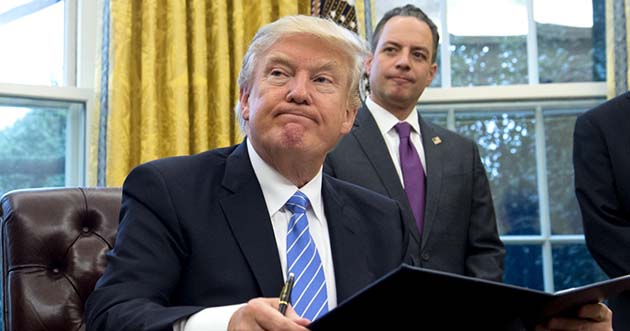Trump’s first days in power produced a sweeping series of executive orders. Most dramatic was his ban on people from seven Muslim majority countries entering the US.
Many hoped that the arrogant and bigoted style of Trump’s election campaign might fade when he became President. But the Trump on display during his campaign was not just an act—he has a history of racist and sexist outbursts dating back decades.
In his inauguration speech Trump declared that “the hour of action” had arrived. His flurry of presidential orders was intended to present him as a decisive leader able to deliver dramatic change.
Trump stands for an extreme “America first” nationalism. His effort to close the borders to refugees, Muslims and immigrants goes along with an attack on foreign countries and foreign workers for taking American jobs.
Trump’s open and explicit racism goes further than the coded appeals to bigotry more common among mainstream political leaders. His politics are the equivalent of a far right leader like Pauline Hanson.
But the continuities between the Obama administration and Trump are greater than often appreciated. Obama deported more than 2.4 million immigrants, while Trump has said he wants to deport two to three million. Obama created an apparatus for carrying out deportations that Trump will build on.
After 9/11 the Bush administration created a registry requiring males from 25 designated countries, all but one of them Muslim or Arab majority countries, to sit special immigration interviews when entering or leaving the US. It registered and tracked over 80,000 people. The Obama administration maintained it until immigration officials decided it was unnecessary due to new technology in 2011. Obama only attempted to shut it down permanently one month before leaving office.
Trump has built upon the racism generated by the presidencies of Obama and George W Bush through 15 years of war in the Middle East and scaremongering about terrorism.
Ruling for the rich
Trump also shares the aims of the rich and powerful of boosting corporate profits, as part of the 1 per cent himself. The stockmarkets soared following his election, as big business recognised that his policies could work for them.
Despite his populist rhetoric about “draining the swamp” of vested interests controlling politics, he has stacked his administration with bankers from Goldman Sachs, the very firm he attacked during his campaign as having “total control” over Hillary Clinton.
Gary Cohn, who resigned as number two at the bank to head his National Economic Council, revealed that Trump is preparing to unwind controls on the banks imposed after the 2008 financial crisis.
Like the Republican Congress, Trump supports massive tax cuts for the super-rich—classic neo-liberal trickle-down economics. The top 1 per cent would get 47 per cent of the benefit of his proposed tax cuts in their first year, taking back on average over $200,000 each. He also plans to slash corporate tax from 35 to just 15 per cent. All this, along with plans for cuts to government programs like Obamacare, will hurt working class people’s living standards.
However Trump’s support for protectionism and his views on foreign policy are regarded with unease by the political establishment and the ruling class.
Trump has threatened to impose a 35 per cent “border tax” on Mexico to keep manufacturing in the US, withdrawn from the Trans-Pacific Partnership and promised to re-negotiate the North American Free Trade Agreement.
Key adviser Steve Bannon sees protectionism and infrastructure projects to deliver jobs as key to creating what he calls an “economic nationalist movement”.
But Trump’s $1 trillion plan to rebuild the country’s broken down infrastructure rests largely on tax breaks for corporations and privatisation, rather than government spending to create jobs.
How far Trump will push for protectionist policies against countries like Mexico and China is unclear. But promising to deport millions of immigrants and scapegoating foreign workers for job losses is a way of directing the anger and bitterness in the US in a racist direction.
Trump’s election is due to a crisis of legitimacy of the political system. Hillary Clinton was simply unable to motivate voters in the key states of the Midwest to turn out to vote in anything like the same numbers even as Obama four years before. For working class people whose lives have gotten worse through the economic crisis, she offered anything but change. Trump’s populist attacks on the Washington elite combined with racism allowed him to win just enough votes to scrape into power.
His popularity for an incoming President is a record low, and will drop further as he fails to deliver the jobs or the end to corporate domination he promised.
As millions across the US take to the streets against Trump, the opening for a socialist alternative linking opposition to racism with demands to make the bankers and the corporations pay for jobs and services is clear.
By James Supple






